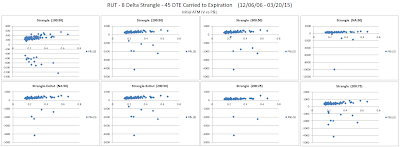This post looks at selling one-lot strangles on the RUT, initiated at 45 days-to-expiration (DTE). The results displayed below represent data from 2288 individual trades entered by the backtester. The results are grouped by the delta of the short strikes. For example, a 4 delta strangle is constructed by selling a -4 delta put, and selling a +4 delta call.
In the trade metrics tables, I have highlighted some of the rows of data to indicate values that are in the upper half of the readings. One of the metrics to note is the average P&L per day in percentage terms (Trade Details (%) - Avg. P&L / Day). This is a measure of the P&L per day normalized to the maximum initial portfolio margin (initial PM) required for that trade run...it tells us the effectiveness of theta with respect to our margin requirement.
4 Delta Short Strikes
 |
| (click to enlarge) |
 |
| (click to enlarge) |
6 Delta Short Strikes
 |
| (click to enlarge) |
 |
| (click to enlarge) |
8 Delta Short Strikes
 |
| (click to enlarge) |
 |
| (click to enlarge) |
Below are three sets of scatter plots for the 45 DTE 8 delta short strangles. The first set contains one scatter plot per strategy and shows P&L in dollar terms versus days-in-trade (DIT). The one obvious trend in these scatter plots is that the largest losses tend to occur at lower DIT values. Also, as the DIT increase, the losses tend to get smaller for most of the exit approaches.
 |
| (click to enlarge) |
The second set of images shows P&L in terms of the initial at-the-money (ATM) implied volatility (IV) of the RUT. This ATM IV was captured on the day each trade was initiated. In general, there is a trend that higher P&L numbers are associated with higher ATM IV numbers. Also, the largest losses tend to occur at lower IV.
 |
| (click to enlarge) |
The last set of images shows P&L in terms of the initial IV Rank for the RUT. The IV Rank was captured on the day each trade was initiated. In general, there is a trend that higher IV rank is associated with higher P&L. Also note that if you trade only when IV rank is higher, you can eliminate many losing trades.
 |
| (click to enlarge) |
In the next post we will look at these same deltas and exits, but on the RUT 52 DTE short strangle.
Follow my blog by email, RSS or Twitter. All options are free, and are available on the top of the right hand navigation column under the headings "Subscribe To RSS Feed", "Follow By Email", and "Twitter". I follow blogs by RSS using Feedly, but any RSS reader will work.
No comments:
Post a Comment